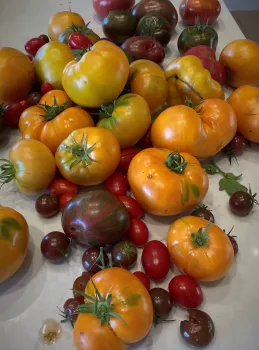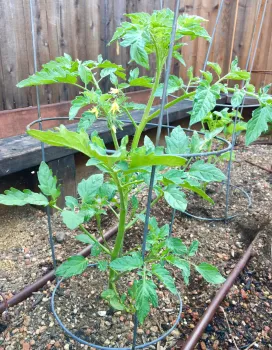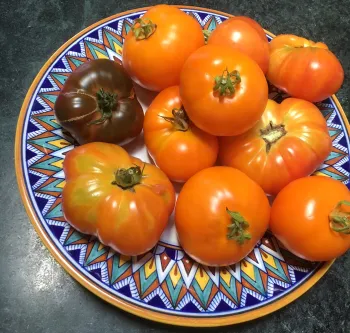
Songwriter Guy Clark tells us there is nothing better than “Homegrown Tomatoes.” Many of us believe this to be true, making tomatoes the most commonly planted garden crop in the United States.
UC Marin Master Gardeners will hold their annual tomato plant sale on April 12, 9:00 a.m., at Bon Air Shopping Center in Greenbrae and the new Pini Ace Hardware in San Marin Plaza, 191 San Marin Drive, Novato. Marin Master Gardeners will answer questions about selecting and planting tomatoes.
Tomatoes are a tropical crop native to areas in South America from Ecuador to northern Chile. They belong to the large nightshade genus Solanum, along with other members, including peppers, potatoes, tomatillos, eggplant, herbs, vines, shrubs, and trees.
Tomatoes grow in different sizes and a variety of colors. Choose from beefsteak, heirloom, hybrid, or cherry in shades of red, gold, green, brown or pink. They can be planted in containers, raised beds or in the ground. Some are best for cool coastal climates, and others for heat-tolerant areas. Three new varieties are available this year. Magic Bullet is a cherry tomato that is good for containers and cool coastal gardens. Pink Berkeley Tie Dye is a medium-sized wine-colored beefsteak/slicer with neon green stripes and pink inside. Mortgage Lifter is a red beefsteak heirloom with meaty fruit and exceptional flavor.
To prevent diseases, buy disease-resistant varieties appropriate for growing in your microclimate. The best location is full sun, with at least 6 hours of sun or more, and medium-texture, well-drained soil. If soil is lacking, amend it with compost or other nitrogen-bearing amendments. Replace container soil with new potting soil. Add another layer of compost or other amendments to raised beds.

Before planting the seedlings, gradually expose them to the weather to harden them to outside conditions. Wait until the danger of frost has passed. Plant when the seedling has 4-6 leaves and 2 - 3 feet apart. If the plant is leggy, pinch off the bottom leaves and plant horizontally up to the remaining leaves. Gently ease the plants out of the container and separate the roots. Try not to touch the stems because the little hairs can become roots when planted.
Press soil firmly around the plant to form a depression that will hold water. Water plants thoroughly before planting, and after planting, water thoroughly to settle the soil. Avoid extreme fluctuations in soil moisture, as these conditions increase the incidence of fruit cracking and blossom end rot.
Pruning is unnecessary, but if you decide to prune to one leader, the plant will bear fruit earlier but yield less.
Additional fertilizer is not required before flower and fruit set are ongoing. Overhead watering is not recommended, but the soil needs to be watered often and not allowed to dry out. Drip irrigation works well. Tomatoes are ready when there is a slight give, and they easily pop off the stem.

Heirloom plants have been grown for over 50 years. They are generally robust and have abundant flavor. Seeds may be saved for propagation.
Hybrid plants have controlled pollination, thereby creating plants with desired traits such as disease resistance. Seeds will not produce true-to-type plants unless they are purchased.
Determinate plants tend to grow bushy to a given size, 3-5 feet, produce fruit for 4 to 6 weeks, and then decline. These are typically canning types.
Indeterminate plants grow tall, needing support from cages, trellises, or stakes.
By Sara O’Keefe, April 5, 2025

